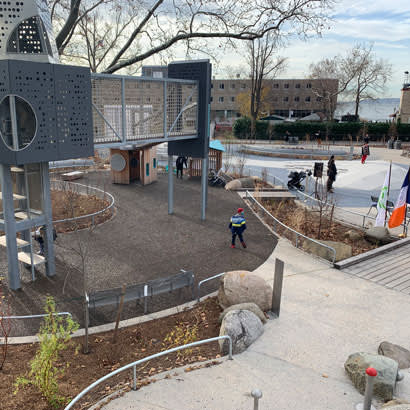
As many cities are located along coastlines, riverbanks, lakeshores and other bodies of water, building structures and spaces capable of withstanding flood events is of paramount importance in today’s urban spaces. While much of the attention today focuses on urban infrastructure resiliency, parks and other recreational areas can also help make cities more resilient. The recently completed Battery Playscape in New York City offers an example of how to make resiliency a key component of a project while delivering a new and unique playground.
Capping the redevelopment of Battery Park at the southern tip of Manhattan in New York City, the Battery Playscape is an accessible, creative and educational destination. The 1.5-acre Playscape project was managed by the New York City Department of Parks and Recreation (NYCDPR) with support from Hill International, Inc., and was designed by BKSK Architects and Starr Whitehouse Landscape Architects and Planners, and built by contractor Paul J. Scariano, Inc. While a challenging project involving numerous stakeholders, custom elements and materials, and all the logistical and staging constraints of working in Lower Manhattan, the result is a one-of-a-kind destination that inspires play while helping to contain flood events.
Hill’s Salim Short, CCM, EIT, managed the project, with senior management oversight provided by project director Gene McGarry, CCM, RLA. McGarry has worked on NYCDPR projects in New York City for more than 20 years. Short said of the project: “The Playscape is an example of what you can do with a dedicated team. From the leadership and financial support of the Battery Conservancy to the global team of designers and vendors, everybody bought into the project’s vision of a responsive and resilient place for play.”
Resilient by Design
Battery Playscape’s biodiversity will likely serve as an exemplar for urban flood zone landscapes around the world. Located at the promontory of Manhattan Island where the Hudson River meets New York Harbor, the playground is sited on low-lying land and is vulnerable to storm surges and flooding. So, it was designed and built for resiliency, with the capacity to hold 30,000 gallons of stormwater.
In addition, many key features of the Playscape are built high above the flood line, minimizing any damage to the equipment during storm events. Other resiliency features of the award-winning landscape design of the Playscape include impermeable paving to direct surface runoff to rain gardens and plants selected for their high salt tolerance. Short explains: “NYCDPR knows climate change is going to impact New York, so they’ve committed to building green infrastructure into everything they do. The Playscape might be the most high-profile example of that goal.”
McGarry, who oversees all of Hill’s work with NYCDPR, as well as other projects and programs involving resiliency infrastructure along the Hudson River in both New York and New Jersey, added, “NYCDPR is focused on the importance of sustainable and ecologically friendly parks in the city. Of [the department’s] nearly 30,000 acres of space, more than a third of that is forest, woods, wetlands and saltwater marsh. Those spaces need to be protected and maintained, of course, but they can also help protect the city. The Playscape shows one way that can happen.”
Playing with Ecology
For children visiting the park, of course, the opportunity to learn and play on the park’s many unique features and equipment is the most important consideration. The Playscape features five “zones:” Bluff with five granite slides; Riverbed and Marsh with salt-tolerant gardens, elevated tree houses and sand/water play; and Dune and Meadow presenting ShowBox, the first improv/puppet theater in a New York City playground.
Each zone reflects its own typology, with custom play equipment and structures and plantings. These zones encourage play while also educating children on the unique ecologies of marshlands and rocky bluffs. “The features here are amazing,” says Short. “They come from around the world, and a lot are one-of-a-kind.” Specific features include:
- Buried “fossils” for children to discover in the Dune zone
- The highest ADA-accessible point in a New York City park in the Bluff zone, with striking views of the harbor and the Statue of Liberty
- Poured safety surfaces throughout
- Water features in the Riverbed zone
- Architectural walls representing “cliffs” in the Bluff zone
- A climbing wall of pre-cast components
- Stamped metal shade structures in the Dune zone
Revitalized and Ready to Inspire
The Battery Playscape project also marked the final component of the revitalization of Battery Park, New York City's oldest continually used public space. “This is going to be the model for how to integrate resilient design into public spaces for years to come,” said McGarry. “As well as play where kids come to learn, explore, and just have fun.”
Christopher A. Miller is responsible for providing writing and editorial support for Hill International’s projects and has more than 15 years of technical and marketing writing experience. He interviews project managers, subject matter experts and others to create persuasive and informative content for Hill’s clients and industry colleagues.


